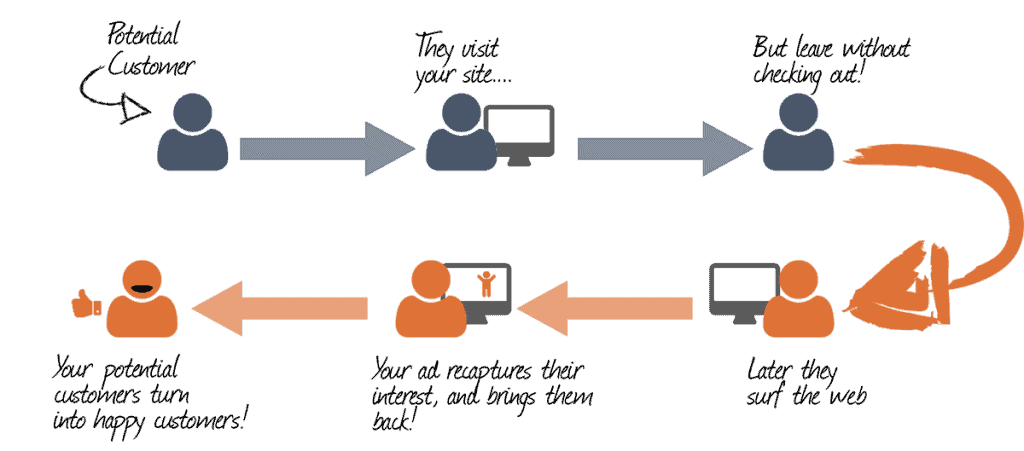You’ve heard the term and you probably have a basic understanding of what it means to segment your subscribers.
This is one of those things that I’ve been aware of for a long time, but I didn’t really understand the power in it until the last few years when I started running Facebook ads.
It was the first time I had heard the term retargeting. If you haven’t run paid ads you’re probably not familiar with this from the advertisers perspective, but as a consumer, you’re hit with it every day all day when you’re online. Here’s a perfect example of how retargeting works:
This morning I got an email (newsletter) from a friend of mine. He mentioned a planner he uses called ‘The Productivity Planner’. I hadn’t seen it before (we’ve been inundated with physical planners for the last couple of years. There’s pretty much a plethora to choose from to keep you on task). I clicked through to see what it was (I had seen it) and within about 2 hours I saw an ad on Facebook in my newsfeed for the Productivity Planner.
Pretty powerful stuff.
Here are a better explanation and diagram of what retargeting is from Retargeter.com:
“Retargeting is a cookie-based technology that uses a simple Javascript code to anonymously ‘follow’ your audience all over the Web.
Here’s how it works: you place a small, unobtrusive piece of code on your website (this code is sometimes referred to as a pixel). The code, or pixel, is unnoticeable to your site visitors and won’t affect your site’s performance. Every time a new visitor comes to your site, the code drops an anonymous browser cookie. Later, when your cookied visitors browse the Web, the cookie will let your retargeting provider know when to serve ads, ensuring that your ads are served to only to people who have previously visited your site.”

As much as I was being funny, I was also serious.
Getting Started with Segmenting
Depending on your ESP (email service provider), there are different ways to start segmenting subscribers.
The most basic way (and a little old school), was simply to have different email lists. The problem with only having lists is that it gets a little confusing. It’s much easier to have one list with different tags. Then the tags allow you to communicate and market to your subscribers based on their tag only.
It would almost be like having different websites for specific categories as opposed to one website with multiple categories. The list is the ‘parent’ and the tags are the ‘child’.
If you can't segment subscribers with tags, consider switching to a service provider that does. If your ESP doesn’t allow basic segmenting with tags, consider switching to a service provider that does. This might seem a little dramatic, but the sooner you make the move the better. It’s better to invest the time and money in the right tools as soon as you possibly can than to have to go back and clean things up after the fact.
There are a handful of email service providers that will do this for you, but we recommend MailChimp and Drip (you can get started for free with Drip). The power of Drip is pretty amazing (we’ve just made the move and are barely scratching the surface with what is possible). If you're looking for an affordable Mailchimp Alternative, you should take a look at SendX.
While we love Drip for all it does, it’s probably a little more advanced if you’re just getting started. If you’re new to all of this, then consider trying ConvertKit or Active Campaign.
When you’re getting started with segmentation, I like to start with the end in mind. Meaning, what is the end goal of acquiring your new lead? (for the sake of keeping this more direct, we’re going to assume your goal is also to build a long-term relationship with your subscriber by providing value and connecting with them as well).
What are you selling?
Let’s say you have 3 different things for sale on your website:
- Digital course on list building
- Coaching on automation and marketing
- Done-for-you service on email set-up & automation
We’ll assume that item #1 (digital course), is more entry-level and costs the least. Item #2 (coaching), is a more expensive option, and finally, item #3 (done-for-you), is the “premium” offer (costs the most).
While all three of these are related, they’re also targeting a different person who is at a different stage in business. It’s also a natural ‘customer journey’ to progress through. So you may have someone who buys your digital course on list building, then down the road, they realize they need something a little more complex. They figured out how to get their lead magnet up on their site but now they want to add a few content upgrades. They come to you for your coaching and instruction (item #2). Finally, after they have a few content upgrades on their site they realize there is still more automation that can be implemented so they come back to you for your ‘done-for-you’ service.
The progression through each step is natural, but not everyone who subscribes to you will need the same solution (it’s great if you have a lead magnet that appeals to the masses, but then take it a step further and start offering more).
When you know where you ultimately want your subscribers to end up (as a customer), it’s much easier to start adding segmentation into your inbound marketing efforts.
Basic Segmentation
If you’re new to all of this the best place to start is simply by implementing tags.
Before you start creating random tags though come up with a tagging framework that makes sense to you and you can be consistent with (otherwise you end up as I did with a bunch of random tags that have to be re-assigned). This is simply a method of naming and organizing your tags. I like this because the prefixes she uses make sense and are easy to implement).
If you only have one lead magnet on your site, that’s fine.
Start with something like “[LM] Name of lead magnet” as a tag.
I’m not going to get into advanced automation steps (yet). The initial goal of getting started with basic segmentation is that you start putting your subscribers into different groups based on their actions. If you only have one lead magnet (no content upgrades), you can start tagging them based on actions in a follow-up email sequence.
So in the example give above with the three offerings (of what is for sale), if you only have one lead magnet on list building then you would want a follow-up sequence that sends people to each offer you have (or content that is relevant to that offering).
This would look something like this:
- Lead Magnet Name (tagged as [LM] lead magnet name)
- Email #1 (send immediately): Welcome and thank you with a link to download your lead magnet
- Email #2 (send 1 day after email #1): Send to a blog post on automation. When your new subscriber clicks the link in your email to your automation post they get tagged with an interest in automation ([INT] Automation – the INT stands for interest)
- Email #3 (send 1 day after email #2): Send to a podcast episode (or blog post case study) where you show what you achieved for someone who hired you for coaching. Tag them with [INT] Coaching (the trigger for the tag is the link in the email)
- Email #4 (send 2 day after email #3): Send them to your done-for-you page. Anyone who clicks this link is tagged with [INT] Done-for-you
So even though you only have one lead magnet, you can segment your subscribers based on the actions they take when reading your emails and clicking the links in the email.
Make sense?
This is where you should start with segmenting and automation.
Don’t worry about a bunch of other automation and ninja tricks until you have the basics down. And make sure you have a tracking script/pixel on your site if your ESP provides you with one (most companies do).
What’s Coming
Everything is moving towards a personalized experience. It doesn’t matter if its dynamic tags, retargeting, custom content, or visitor behavior. The more you can tailor a visit to your website based on your subscribers previous action the more likely they are to become a customer.
Start getting your foundation set today.
Segment your subscribers as best you can and communicate with them based on their behaviors. Once you’ve mastered this you can move into becoming an automation ninja.
